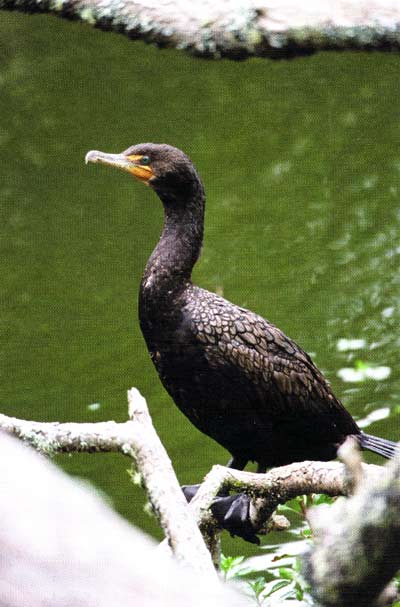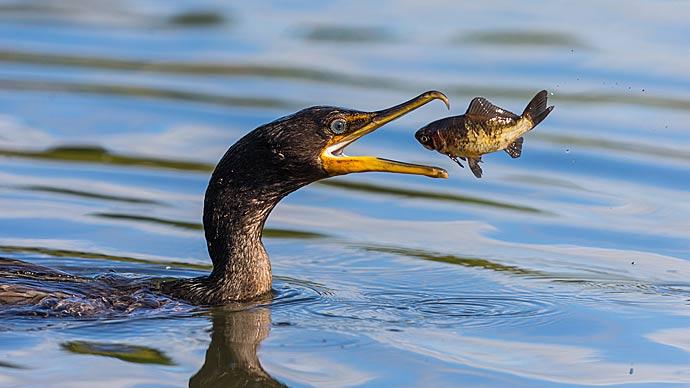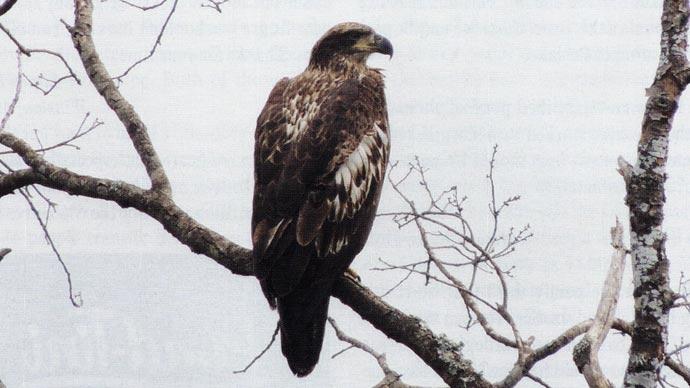
Predator-prey interactions and relationships are central to the management of pond systems. Pond owners must assess for population imbalances, which can be caused by excess predation. Most often, pond managers focus on excess predation by other fish, such as Largemouth bass on bluegill. Diet studies can reveal the structure of the food web, how species interact within a community, and the possible effects on populations.
Estimates of available prey specie abundance can indicate how and what predators select as prey. All of this information is essential for understanding and management of the dynamics of predator-prey status. Diet studies conducted briefly may not reveal the full range of results, especially when predation varies over time and comes in large events. Fish-eating waterbirds, such as double-crested cormorants (cormorants hereafter), are top predators in many aquatic systems, and several studies have demonstrated that they can, in short time frames, significantly affect fish populations in small waters.
The Pond Boss Forum has numerous threads with firsthand accounts of cormorants damaging owners' waters. The degree of potential cormorant impacts can depend on several conditions, including the amount of foraging pressure exerted by cormorants, the composition of the available prey base, and the types of prey selected. Fish community structure and prey selection will naturally affect what type and how much of an impact cormorant predation causes on a sport fishery.
Variability exhibited in cormorant diets across various waters has characterized cormorants as generalist predators consuming prey as encountered within a particular environment. However, variability in diet composition does not mean that cormorants are not selective predators. Common sense tells us predators try to maximize results with as little effort as possible. This is basic foraging theory.
Detailed studies of cormorant feeding activity are rare because they require a lot of time and effort to compare diets with quantitative estimates of prey abundance, which are seldom available.
One such study is Analysis of Prey Selection by Double-Crested Cormorants: A 15-Year Diet Study in Oneida Lake. New York by Robin L. DeBruyne, Jeremy T. H. Coleman, James R. Jackson, Lars G. Rudstam, and Anthony J. VanDeValk in Transactions of the American Fisheries Society. 142:2,430-446.
Long-term studies, like the one above, of cormorant diets in conjunction with information on fish community structure are rare but highly valuable for detailed characterization of the foraging behavior of the controversial cormorant. The authors' note that in this location cormorants have been implicated in the decline of walleye and yellow perch populations, the two prominent species anglers seek. The authors were particularly interested in how cormorant consumption of these species was affected by their abundance and the presence of alternative prey species such as gizzard shad and Emerald shiner. This is interesting in light of the observations by Pond Boss Forum members of the apparent selection by cormorants of waters that have easily visible open-water pelagic prey such as shads.
Prey switching (when predators disproportionately consume alternative prey when original prey becomes rare relative to the alternative prey) was also investigated by comparing cormorant diets in years with contrasting prey fish abundance. Prey switching can stabilize predator-prey interactions by reducing the extent of prey abundance fluctuations and be more complete if different prey requires different foraging tactics. For example, cormorants may show differential preference between feeding on open-water schooling fishes like Gizzard Shad, Emerald Shiner, or Alewife as compared with benthic fish species such as Yellow Perch, Round Goby, or Walleye.
In this study, across all years, the most commonly identified prey species of cormorants numerically in summer were yellow perch (57.0%) and walleye (9.7%). And logperch (8.9%).
However, in the fall, gizzard shad (54.8%), yellow perch (20.1%), and Emerald shiner (14.2%) were the most frequently consumed species.
When Age-0 Gizzard Shad were present, they typically began in cormorant diet samples in late July or early August at sizes larger than 45 mm. They continued to be present in the samples throughout the fall season. The ten species with the highest overall percent occurrence by weight were (in order) yellow perch, walleye, Gizzard Shad, Sunfish spp., Burbot, White Perch, White Sucker, Rock Bass, Smallmouth Bass, and Logperch. Like percent by number, percent by weight was highly variable across years and seasons.
Cormorant consumption of Emerald shiners and gizzard shad increased as these species became larger and more abundant in late summer (young age 0 Emerald shiners and gizzard shad are too small to pursue). However, similar increases in consumption and increased availability were not observed with other common species in cormorant diets, such as walleye and yellow perch. These results suggest that cormorants display prey switching to Emerald shiners and gizzard shad when these species are available in high abundance. Late-year Age-0 gizzard shad and Emerald shiners still lack rigid spines, are soft-bodied, and typically form schools of high-content food energy. On the other hand, adult walleye and yellow perch have spines and do not traditionally form large schools. Therefore, the pursuit and handling time for walleye and yellow perch could be higher than for gizzard shad and Emerald shiner. Cormorants also use social foraging strategies (groups of birds herding fish), considered more efficient for pursuing schooling prey.
Cormorants are not welcome in most private sportfish waters because of the damage they can inflict. You now have a little info on what cormorants eat and when. The bottom line is that they will eat what is most easily available (most energy for the effort) based on standard foraging theory.
Reprinted with permission from Pond Boss Magazine



